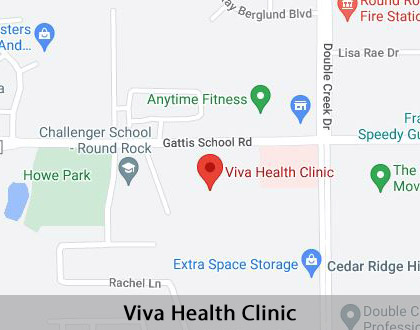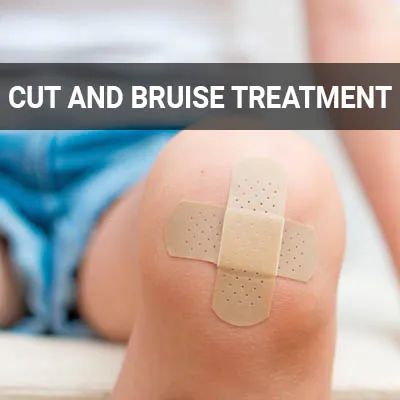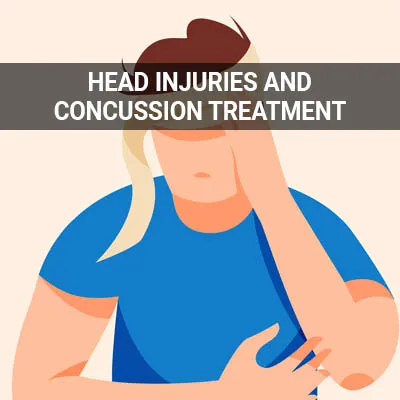Eye Injury Treatment Round Rock, TX
Receiving prompt care for eye injuries is crucial to preventing developing long-term complications as a result. While it is possible to sometimes treat minor eye injuries at home, untreated eye injuries can cause loss of eyesight, severe pain, or bleeding. Our primary care practitioner can provide effective treatment for all types of eye injuries and refer patients to a specialist when they are needed.
Eye injury exams and treatment are available at Viva Health Clinic in Round Rock and the surrounding area. Our staff can help you determine how serious the eye injury is and refer you to a specialist if needed. Call us at (512) 243-5872 to get evaluated today.
Eye Injuries
An eye injury can occur while simply walking down the street or in the comfort of one's own home. An eye injury of any kind that becomes extremely painful or concerning should be given immediate medical care to prevent more serious complications, such as chronic pain, reduced vision, or even blindness. A few of the most common eye injuries include corneal abrasion, foreign objects in the eye, swollen or black eye, and subconjunctival hemorrhages.
The American Academy of Ophthalmology, (AAO) states that nearly half of all eye injuries occur at home with more than 40 percent of all eye injuries being related to sports or recreational activities. The AAO adds that 60 percent of injured workers lacked appropriate eye protection at the time of the accident. This is where our primary care practice can help by providing the necessary treatment. Understanding the types of eye injuries can help patients determine the most effective course of action for treatment.
“An eye injury can occur while simply walking down the street or in the comfort of one’s own home.”
Corneal Abrasion
A corneal abrasion, a scratched cornea or scratched eye, is one of the most common eye injuries. While it is a serious eye injury, a medical professional on our team can help treat it quickly and effectively. Most corneal abrasions are caused by a finger, a small yet damaging particle, or a makeup brush. In most instances, a corneal abrasion is recognizable since it typically causes pain.
The treatment we provide for a corneal abrasion depends on its severity. If the abrasion is minor, then it can be treated with a protective eye drop solution and proper rest. The majority of minor corneal abrasions tend to heal within three or four days. However, more serious corneal abrasions require more extensive treatment, such as protective eyewear, and may take up to several weeks to fully heal.
Although corneal abrasions are not always easy to prevent, there are certain precautions one can take. Patients should wear protective eyewear when in an environment that puts them at higher risk, such as a construction zone. Also, it is not uncommon for a corneal abrasion to occur after dry eyes. Therefore, patients should be sure to keep their eyes lubricated and properly cared for.
“Most corneal abrasions are caused by a finger, a small yet damaging particle, or a makeup brush.”
Foreign Objects and Substances
A foreign object or substance in the eye is when a substance not produced by the body or a foreign object enters the eye. Foreign substances cause a significant amount of discomfort and can be incredibly difficult to remove. When a foreign substance enters the eye, it usually creates a feeling of intense pressure and causes excessive blinking.
A foreign substance can enter the eye anywhere and at any time if the eye is unprotected. It can result from something as simple as dust particles floating around. Although it can be difficult to control what enters the eyes, certain areas pose a greater risk, such as construction zones where there is a lot of dust and broken glass around. Wearing protective eyewear when cutting grass, working in a construction zone, or dealing with chemicals is important in preventing eye damage.
Depending on the size and material of the substance, medical assistance may be necessary to treat it properly. If the object that enters the eye causes a minor level of pain, it can be washed out at home, and there is no real need for medical assistance. However, if the object causes immediate, severe pain or pain that lasts for more than an hour, we can professionally clean the eye to prevent long-term damage.
“Although it can be difficult to control what enters the eyes, certain areas pose a greater risk, such as construction zones where there is a lot of dust and broken glass around.”
Check out what others are saying about our primary care practitioner services on Yelp: Eye Injury Treatment in Round Rock, TX
Swollen or Black Eye
A swollen or black eye occurs when blood and other fluids gather around the eye region, typically after suffering a blow to the eye. In most instances, this is a minor injury that heals within several days and does not lead to any long-term complications. However, more serious blows to the eye can cause significant damage and even blindness in the affected eye(s).
The main cause of a swollen or black eye is a sudden, unexpected blow to the eye, such as getting punched, hit by a moving object (i.e., a baseball), or falling and hitting the eye on a hard surface. However, one may experience a swollen eye as a result of surgical procedures, allergies, or skin infections, such as cellulitis. Along with excessive swelling, a black eye typically shows signs of discoloration and increased sensitivity.
After suffering a swollen or black eye and receiving treatment, certain home care techniques can help reduce the recovery time and keep the pain at a manageable level. Reduce the swelling (typically the main cause of discomfort) by icing the affected area several times a day, taking an anti-inflammatory medication, and resting the eyes and body as much as possible.
For minor swollen or black eyes, discoloration and swelling should gradually dissipate within a few days. However, if a swollen eye leads to vision loss or severe pain, or if the swelling does not start to go away after several days, one should seek medical intervention. Otherwise, it may heal improperly and cause unnecessary long-term complications.
“Along with excessive swelling, a black eye typically shows signs of discoloration and increased sensitivity.”
Questions Answered on This Page
Q. What are the most common eye injuries?
Q. What is a corneal abrasion and how is it treated?
Q. How do foreign objects or substances affect the eyes?
Q. How are swollen or black eyes considered an eye injury?
Q. What is a subconjunctival hemorrhage?
People Also Ask
Q. What other injuries can a primary care practitioner treat?
Q. What are some common illnesses people see practitioners for?
Subconjunctival Hemorrhages
A subconjunctival hemorrhage occurs when the blood vessels underneath the clear surface of the eye rupture, causing the blood to be trapped and unable to be reabsorbed. Although subconjunctival hemorrhage symptoms may seem quite concerning on the surface, it is a fairly minor injury. In most cases, there are no noticeable signs of a subconjunctival hemorrhage other than extremely bright redness, which typically lasts a week.
The cause of subconjunctival hemorrhages is not fully understood, which makes it extremely difficult to prevent. However, certain behavior patterns can increase the likelihood of this issue, including straining, chronic coughing, and constant rubbing. It is important to keep the eye properly lubricated using eye drops designed to prevent dry eyes, redness, and irritation. The most effective way to prevent a subconjunctival hemorrhage is by getting the proper amount of rest each night, keeping the eyes lubricated, and taking constant breaks, especially when working on a digital device for long periods of time each day.
“It is important to keep the eye properly lubricated using eye drops designed to prevent dry eyes, redness, and irritation.”
Frequently Asked Questions
Q. What are the most common types of eye injuries at home vs. at work?
A. The most common types of eye injuries that occur at home are typically due to a blow to the eye, such as being hit by a baseball or tripping on a staircase and hitting your eye. At work, eye injuries typically result from exposure to a chemical or substance, especially when working in a laboratory or an outdoor area. While preventing an eye injury at home can be tricky, you can help reduce the chance by making your home safer. At work, be sure to wear protective eyewear when in high-risk areas, such as a construction zone or laboratory.
Q. How do I wash my child's eyes after they have been exposed to a chemical?
A. Getting a chemical in the eye is one of the more serious eye injuries, and it requires prompt treatment to avoid any long-term effects. First, find the nearest water source — typically a sink — and thoroughly wash the eyes out for 15 minutes. As you rinse, hold the eye(s) open with your fingers to ensure the water is able to clean out the chemical. After washing the eye out thoroughly, our primary care practitioner can ensure you receive proper eye treatment and there are no long-term concerns to worry about.
Q. Who do I contact if my eye is bleeding?
A. If your eye is bleeding, it is important to seek medical assistance as soon as possible. With that said, the cause of the bleeding dictates how severe the injury is. If it is due to a blow to the eye, but you can still see, then there is less cause for concern. Regardless, you should still have our primary care center check it out. However, if you are unable to see after the blow to the eye or it occurs due to exposure to a chemical, the issue will likely require a 911 call.
Q. What are the most common causes of eye injuries?
A. Eye injuries can result from a blow to the eye (if a particle or chemical enters the eye) or a subconjunctival hemorrhage (which leads to severe redness and eye discomfort). Any symptoms suggesting an eye injury require immediate professional opinion and possible treatment. With proper and prompt treatment, most minor eye injuries do not carry any long-term risks.
Q. My vision still has not returned since being treated for my eye injury. What do I do now?
A. Be sure to visit an optometrist if you believe you have lost your vision, regardless of whether you believe it is temporary or long-term. While it is normal to have diminished vision for certain eye injuries, the complete loss of vision after an eye injury of any kind is not normal and suggests something may be wrong. In order to ease anxiety, understand the scope of the injury and if there is long-term vision loss, consult with an optometrist for.
Start Feeling Better – Visit Us Today
By visiting us as soon as possible, our team can help get you the professional treatment you need. Instead of waiting around and allowing the symptoms to get worse, we can provide you with treatment options.
Definition of Medical Terminology
Consult With Us
Whether an injury is the result of a blow to the eye, a foreign substance in the eye, or a non-contact eye injury, we have the knowledge and resources available to provide professional medical care. If you are concerned about an eye injury and its severity, call us at 512-243-5872 to speak to Viva Health Clinic and schedule an appointment.
Helpful Related Links
- American Academy of Opthemology. American Academy of Opthemology. 2023
- American Journal of Medicine. American Journal of Medicine. 2023
- American Medical Association (AMA). American Medical Association (AMA). 2023
- American Optometric Association. American Optometric Association. 2023
- The National Institute for Occupational Safety and Health (NIOSH). The National Institute for Occupational Safety and Health (NIOSH). 2023
- United States Department of Labor OSHA. United States Department of Labor OSHA. 2023
About our business and website security
- Viva Health Clinic was established in 2023.
- We accept the following payment methods: American Express, Cash, Discover, MasterCard, and Visa
- We serve patients from the following counties: Williamson, Travis, McLennan
- We serve patients from the following cities: Pflugerville, Austin, Kyle, Waco, Leander, Cedar Park, Bastrop, Round Rock, Georgetown, Hutto, Liberty Hill, and Taylor
- National Provider Identifier Database (1104428416). View NPI Registry Information
- Norton Safe Web. View Details
- Trend Micro Site Safety Center. View Details
Back to top of Eye Injury Treatment










